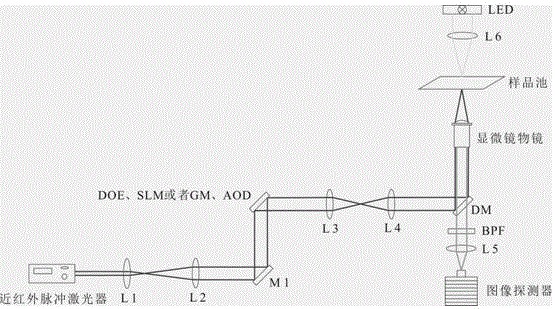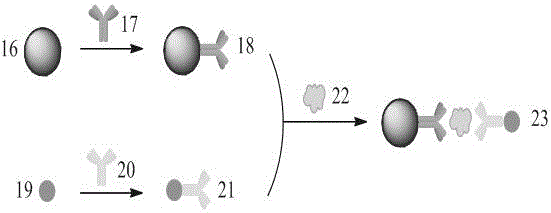Liquid-phase suspension biochip based on multi-optical trap encoding bead array and two-photon fluorescence detection
A biochip, coding microsphere technology, applied in fluorescence/phosphorescence, measurement devices, material analysis by optical means, etc., can solve the problem of limited number of optical traps, and achieve the simplification of enrichment process, cost reduction, and simplification of structure. Effect
- Summary
- Abstract
- Description
- Claims
- Application Information
AI Technical Summary
Problems solved by technology
Method used
Image
Examples
Embodiment 1
[0048] Detection of five liver cancer markers AFP, CEA, Glypican-3 (GPC-3), abnormal prothrombin (DCP) and α-L-fucosidase (AFU)
[0049] Five 3μm colored microspheres (blue, green, yellow, red, colorless) with surface modified carboxyl groups were used as color-coded microspheres, and AFP, CEA, GPC-3, DCP were enriched by two-site sandwich method. , AFU antigen, and use quantum dots with emission wavelength of 605nm as fluorescent labeling materials, such as image 3 Shown.
[0050] The first step is to prepare immuno-encoded microspheres. Take one of the blue coded microspheres 16 modified with surface carboxyl groups, first activate the carboxyl groups on the surface of the microspheres through the EDC / NHS reaction, and then couple one of the AFP monoclonal antibodies 17 at room temperature to obtain immunomicrospheres 18. The preparation methods of the remaining four immuno-encoding microspheres are similar, and finally the five immuno-encoding microspheres are mixed into a buf...
Embodiment 2
[0056] Quantitative detection of H1N1, H3N2, H9N2 three avian influenza viruses
[0057] Using size coding method, the surface modified polystyrene microspheres with particle size of 1μm, 2μm, and 3μm were used as solid-phase carriers, and H1N1, H3N2, H9N2 viruses were enriched by the two-site sandwich method, and emitted Quantum dots with a wavelength of 605nm are used as fluorescent labeling materials, such as Figure 4 Shown.
[0058] The first step is to prepare immuno-encoded microspheres. Take one of the coded microspheres 24 with a surface carboxyl group modification and a particle size of 1 μm. The carboxyl groups on the surface of the microspheres are first activated by the EDC / NHS reaction, and then one of the H1N1 monoclonal antibodies 25 is coupled at room temperature to obtain an immunomicrobe Ball 26, the preparation methods of the other two immunomicrospheres are similar, and finally the three immunoencoding microspheres are mixed into the buffer solution for use. ...
PUM
| Property | Measurement | Unit |
|---|---|---|
| particle diameter | aaaaa | aaaaa |
Abstract
Description
Claims
Application Information
 Login to View More
Login to View More - R&D
- Intellectual Property
- Life Sciences
- Materials
- Tech Scout
- Unparalleled Data Quality
- Higher Quality Content
- 60% Fewer Hallucinations
Browse by: Latest US Patents, China's latest patents, Technical Efficacy Thesaurus, Application Domain, Technology Topic, Popular Technical Reports.
© 2025 PatSnap. All rights reserved.Legal|Privacy policy|Modern Slavery Act Transparency Statement|Sitemap|About US| Contact US: help@patsnap.com



